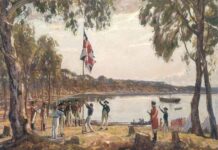 From National Justice Party.
From National Justice Party.
Joseph Jordan
Last Monday the city of Evanston, Illinois voted to release funds that would provide $25,000 to blacks who they assert are victims of residential “zoning,” the first official act of reparations in America. Multiple other cities, such as Detroit and San Francisco, are considering similar measures.
The reparations fad is a racial wealth redistribution program that seeks to take money from white middle class people instead of Wall Street banks and insurance firms whose bloody origins lie in enterprises that enabled slavery and the horrors of the 18th and 19th century cash crop economy.
The idea began gaining traction in 2014, when Jewish warmongerJeffrey Goldberg published Ta-Nehisi Coates’ demand that white America “reckon” with its “compounding moral debts.” All whites by nature, according to Coates and other prominent “anti-racist” figures, must be forced to answer for this original sin.
The reparations argument hinges on the idea that white slave owners were “white supremacists,” and the practice somehow collectively benefitted the white race as a whole in the construction of America, leaving structures in place derived from this legacy that he refers to as “institutional racism.”
On reparations, historical nuance is stymied. As specious as Coates’ arguments are, the only audible counter-arguments are composed of conservative appeals to individualism, which is easily refuted as the United States helped pioneer the idea that nations should be held responsible for historical crimes (see: “Holocaust” reparations).
The white side of the issue is never articulated, despite it being the easiest to logically defend.
Even at the height of slavery, only between 1% to 5% of white households in the whole American population ever utilized captive labor. Interesting, Jewish population disproportionately practiced it, with 5,000 of 20,000 (25%) Jewish families in the South owning at least one slave according to the research of historian Junius Rodriguez published in the Encyclopedia of World Slavery.
So in other words, the vast majority of US whites, including in the South, did not own slaves. The majority of Southern whites were agricultural workers with few intergenerational advancement prospects in the rigid feudalistic system of Dixie, and in their lives, they faced brutal exploitation at the hands of capital that was virtually identical to what black slaves endured, particularly through the practice of debt bondage. The rest of the US white population are descendants of 10s of millions of European immigrants who have either never lived in the South or arrived when the Civil War was already over.
Allocating liability, even if we were to engage in the draconian practice of tracing specific descendants of slave owners, also gets tricky. Scholars and geneticists estimate that African-Americans are between 20 to 30% European, and this mixing occurred almost entirely during slavery, when female slaves had affairs and relationships with their owners in exchange for privileges and, in many cases, freedom.
If you want to reliably locate a direct descendant of a villainous slave owner, find a descendant of their slaves!
The dynamic is arguably exploitive, but historically unremarkable. Entire nations such as Iceland were founded by Vikings who populated their new settlement with captive female concubines they plucked from all around Europe. The prospect of modern Icelanders demanding reparations from Scandinavian countries would be laughed at, but this is a parallel to the absurd American reparations discussion.
Characterizing white planters as feeling allegiance to a multi-generational white collective political project, which is the linchpin assumption of Coates and the 1619 project in their argument for institutional racism, defies common sense.
White and Jewish landlords and capitalists, in fact, behaved in an unusually cosmopolitan way, offending taboos set in place by average whites by systematically fathering children with blacks (so widespread that essentially all American blacks have almost a grandparent’s worth of European ancestry) and then, following the abolition of slavery, the very same culprits conspired in some parts of the South to import waves of Chinese immigrant labor in a scheme to avoid paying white and black workers what their labor was worth.
Southern plantation interests correctly observed how Yankee hypocrites worked immigrants from Asia and Europe to death as less, with 1,200 men dying from savage work conditions and employer neglect during the construction of the trans-continental railroad alone, and wanted to transplant this dynamic to their cotton plantations.
Several prominent Southern planters saw bringing in immigrants, including Asians seen as “heathens” by most locals, as a technical work around laws prohibiting human bondage, just as they had previously imported Africans to the New World. Cash crop capitalists backed the free movement of people, enthusiastically engaged in interracial sexual relations and fought tooth and nail against any nationalist economic policy that put national interests over global free trade ones. Their outlook historically rhymed better with contemporary neo-liberals like Emmanuel Macron than they did with the majority of whites in their time.
This loyalty to their short-term business interests transcended both the medium and long term common good of the white race. After witnessing what transpired during the Haitian Revolution, elite planters knew they were dooming future generations to centuries of chaos that naturally accompanies multi-racial countries, and simply did not care.
It was in fact only through resistance from the organized white working class across America that their plan to use immigrants as their new slaves was thwarted.
Out of this dilemma came the crop-lien system, which was barely aesthetically distinct from chattel slavery.
The life of a sharecropper in the post-bellum South was very similar to the one led by slaves, but in many respects left agricultural workers living in objectively worse conditions while providing substantially higher profits for landowners and usurers. No longer were slave owners socially expected to care for slaves who grew old or became incapacitated in accidents, it was slavery with fewer responsibilities.
Freed colored men often worked for their old master in gangs cultivating cash crops on land they didn’t own just like before the Civil War, but this time keeping for themselves roughly 1/3 of their crop for themselves while handing the rest to the owner.
This figure is misleading. Much of the sharecropper’s share wound up being taken by Jewish merchants and creditors, who took advantage of the fact that workers were no longer provided supplies and were now required to find somebody that would front them money for supplies and tools from the beginning of the six-month work season to harvest.
Greedy landlords did not privilege whites over blacks. 2/3 of all sharecroppers were poor whites, while 1/3 were recently freed blacks returning to their old slave quarters. Under the post-slavery system, capitalists provided nothing but dirt for laborers to sow, with the sharecropper assuming all of the debt and responsibility when there were bad harvests.
This only buried whites and blacks deeper into debt, leading to an explosion in rates of peonage, which was for all intents and purposes slavery under a different name.
The world of high-interest loans in the sharecropper world was dominated by Eastern European Jewish middlemen, who began swarming the South as creditors and peddlers during the Civil War, offering to loan tenant farmers what they needed at rates that guaranteed ownership of their next crop. It was primarily through their role as financiers that Jews rose to become kings of the South’s cotton industry, which drove the demand for slavery throughout the 19th century.
In 1860, cotton made up 60% of America’s national exports, making it the equivalent of commodities like oil today. According to Michael R. Cohen’s 2017 work Cotton Capitalists: American Jewish Entrepreneurship in the Reconstruction Era, a tiny number of Jews controlled 45% of the obscenely profitable cotton economy by the 1860s, largely monopolizing the fields of credit and investment, crop exchanges, exports, and so on.
Mark Twain, who generally admired and defended Jews, described this phenomenon as follows in a 1898 Harper’s Magazine article,
“In the cotton States, after the war, the simple and ignorant negroes made the crops for the white planter on shares. The Jew came down in force, set up shop on the plantation, supplied all the negro’s wants on credit, and at the end of the season was proprietor of the negro’s share of the present crop and of part of his share of the next one. Before long, the whites detested the Jew, and it is doubtful if the negro loved him.”
Southern Jews actively sought to bring out the worst in blacks as it made it easier to part them from their money, much to the chagrin of white fundamentalist Protestants who embraced the “white man’s burden” attitude in hopes of elevating colored people’s condition.
Whatever money rural blacks had leftover after dealing with predatory Jewish loansharks they would frivolously spend on drink and gambling in hives of vice like Beale Street (Memphis), West Ninth Street (Little Rock), and Decatur Street (Atlanta). George Wesley Lee, an NAACP leader, dispassionately described these streets full of rigged casinos, saloons and pawn shops as being “owned by Jews, policed by whites, and enjoyed by the negroes.”
White Southerners would sporadically shut these venues down throughout the 19th and early 20th centuries due to the social problems and violence blacks addicted to low quality, potent liquor sold at almost exclusively Jewish-owned “Colored Only” bars were causing.
In 1906, a race riot broke out in Atlanta after blacks raped four white women, which provoked 48 hours of pitched racial battles between blacks and indignant white men. Investigators uncovered that the blacks were being served despite being heavily intoxicated by Jewish bar owners prior to attacking the white women. White authorities in Atlanta later closed all of the Jewish owned bars.
The specific relationship between Jews and black beguilement was common knowledge in the South, with prestigious magazines like Colliers running investigations into murders of white women by black men that described the connection in detail. In the case of Margaret Lear, a white woman who was murdered by a heavily drunken black, journalist Will Irwin laid the blame at the feet of a St Louis based Jewish cheap liquor producer named Lee Levy, stating that Lear’s killer “wears a white face instead of a black,” and that “Levy’s Nigger Gin” was fueling a wave of black thuggery.
The historical reality is that white slave owners had no genuine allegiance to the white race or interest in its destiny. Whites were exploited as harshly as blacks. Puritanical Christian whites, whether their paternalism was misplaced or not, worked to better the black man’s condition, not hold him down.
It was Jews — the same people who today amplify the grievances of figures like Ta-Nehisi Coates and Ibram Kendi X — who throughout every chapter of black history have ripped them off, exploited their ignorance, encouraged their worst instincts for profit, and undermined their attempts at obtaining dignity and chartering their own path,
If there is any historical responsibility for the present-day condition of blacks in America, it is not ordinary whites being blood libeled today, but Jews who to this day practice a master-slave relationship with the black race, all while brazenly inciting them to violence against us.
From National Justice Party.










